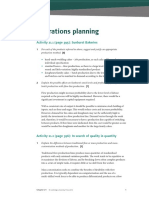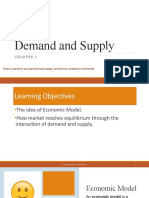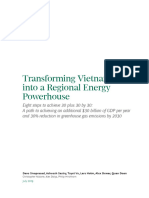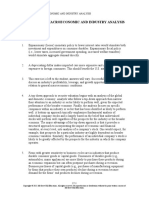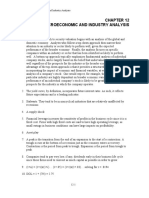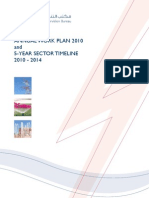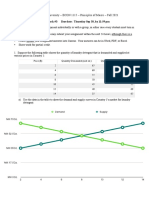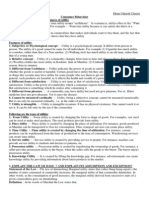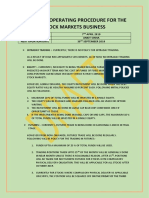0 ratings0% found this document useful (0 votes)
15 viewsCH 9
CH 9
Uploaded by
ksitemporaryCopyright:
© All Rights Reserved
Available Formats
Download as PDF, TXT or read online from Scribd
CH 9
CH 9
Uploaded by
ksitemporary0 ratings0% found this document useful (0 votes)
15 views67 pagesOriginal Title
ch 9
Copyright
© © All Rights Reserved
Available Formats
PDF, TXT or read online from Scribd
Share this document
Did you find this document useful?
Is this content inappropriate?
Copyright:
© All Rights Reserved
Available Formats
Download as PDF, TXT or read online from Scribd
Download as pdf or txt
0 ratings0% found this document useful (0 votes)
15 views67 pagesCH 9
CH 9
Uploaded by
ksitemporaryCopyright:
© All Rights Reserved
Available Formats
Download as PDF, TXT or read online from Scribd
Download as pdf or txt
You are on page 1of 67
Chapter 9
AGGREGATE SUPPLY
AND MACROECONOMIC
EQUILIBRIUM
Ifeanyi Uzoka, Sheridan College
Copyright © 2020 Nelson Education Ltd.
Chapter 9 Preview
9.1 The Aggregate Supply Curve
9.2 Shifts in the Aggregate Supply Curve
9.3 Macroeconomic Equilibrium
Copyright © 2020 Nelson Education Ltd. 2
9.1 The Aggregate Supply Curve
The section will answer the following key questions:
◦ What is the aggregate supply curve?
◦ Why is the short-run aggregate supply curve positively
sloped?
◦ Why is the long-run aggregate supply curve vertical at
the natural rate of output?
Copyright © 2020 Nelson Education Ltd. 3
9.1 The Aggregate Supply Curve
What is the aggregate supply curve?
◦ Aggregate supply (AS) curve is a graphical
representation that shows the positive relationship
between the price level and RGDP supplied.
◦ There are two aggregate supply curves:
Short-run aggregate supply curve (SRAS), and
Long-run aggregate supply curve (LRAS)
Copyright © 2020 Nelson Education Ltd. 4
9.1 The Aggregate Supply Curve
What is the aggregate supply curve? [cont’d]
◦ Short-run aggregate supply (SRAS) curve is the
graphical relationship between RGDP and the price level
when output prices can change but input prices are
unable to adjust.
Copyright © 2020 Nelson Education Ltd. 5
9.1 The Aggregate Supply Curve
What is the aggregate supply curve? [cont’d]
◦ Long-run aggregate supply curve (LRAS) is the
graphical relationship between RGDP and the price level
at which output prices and input prices can fully adjust
to economic changes.
Copyright © 2020 Nelson Education Ltd. 6
9.1 The Aggregate Supply Curve
Exhibit 1: The Short-Run Aggregate Supply Curve
◦ SRAS is upward sloping
◦ Suppliers are willing to
supply more RGDP at
higher price levels and
less at lower price
levels, ceteris paribus.
Copyright © 2020 Nelson Education Ltd. 7
9.1 The Aggregate Supply Curve
Why is the short-run aggregate supply curve
positively sloped?
◦ Two reasons producers are willing to supply more output
when the price level increases:
the profit effect, and
the misperception effect.
Copyright © 2020 Nelson Education Ltd. 8
9.1 The Aggregate Supply Curve
Short-run profit effect:
◦ Input costs are slow to adjust due to long-term contracts.
◦ When price level rises, producers are able to increase
output prices relative to cost.
◦ This increases producers’ short-run profit margins, making
it profitable to expand production and sales at higher price
levels.
Copyright © 2020 Nelson Education Ltd. 9
9.1 The Aggregate Supply Curve
The Misperception effect:
◦ Producers can be fooled into thinking the relative price
of their product has increased, so they supply more
based on the short-run misperception of relative prices.
◦ However, it may simply be that the general price level
has increased.
Copyright © 2020 Nelson Education Ltd. 10
9.1 The Aggregate Supply Curve
Exhibit 2a: The Long-Run Aggregate Supply Curve
o An economy’s stock of
resources and level of
technology define the
position of its production
possibilities curve (PPC),
as illustrated in part (a).
Copyright © 2020 Nelson Education Ltd. 11
9.1 The Aggregate Supply Curve
Why is the long-run aggregate supply curve vertical at
the natural rate of output?
◦ In the long-run:
the level of RGDP that producers are willing to supply is not
affected by changes in the price level.
firms will always produce at the maximum level allowed by
their resources, regardless of the price level.
◦ Therefore, the LRAS curve is vertical.
Copyright © 2020 Nelson Education Ltd. 12
9.1 The Aggregate Supply Curve
Exhibit 2b: The Long-Run Aggregate Supply Curve
o The position of the LRAS curve
is determined by the natural
rate of output, RGDPNR, which
reflects the levels of capital,
land, labour, and technology in
the economy.
Copyright © 2020 Nelson Education Ltd. 13
9.1 The Aggregate Supply Curve
Section Check
◦ The aggregate supply curve is the relationship between the
overall price level and the total quantity of final goods and
services that suppliers are able and willing to produce.
◦ The short-run aggregate supply curve measures how much
RGDP suppliers are willing to produce at different price
levels when input prices are unable to adjust.
Copyright © 2020 Nelson Education Ltd. 14
9.1 The Aggregate Supply Curve
Section Check [cont’d]
◦ For this reason, producers can make a profit by
expanding production when the price level rises.
◦ Producers may be fooled into thinking that the
relative price of the item they produce is rising, so
they increase production.
Copyright © 2020 Nelson Education Ltd. 15
9.1 The Aggregate Supply Curve
Section Check [cont’d]
◦ In the long run, the aggregate supply curve is vertical.
◦ In the long run, input prices change proportionally with
output prices.
◦ The position of the LRAS curve is determined by the level
of capital, land, labour, and technology at the natural rate
of output, RGDPNR.
Copyright © 2020 Nelson Education Ltd. 16
9.2 Shifts in the Aggregate Supply Curve
This section will answer the following key questions:
◦ What factors of production affect the short-run and the
long-run aggregate supply curves?
◦ What factors exclusively shift the short-run aggregate
supply curve?
◦ Can we review the determinants that change aggregate
supply?
Copyright © 2020 Nelson Education Ltd. 17
9.2 Shifts in the Aggregate Supply Curve
What factors of production affect the short-run
and long-run aggregate supply curves?
◦ Any change in the quantity of any factor of production
(capital, land, labour, or technology) can shift both the
long-run and short-run aggregate supply curves.
Copyright © 2020 Nelson Education Ltd. 18
9.2 Shifts in the Aggregate Supply Curve
Exhibit 1: Shifts in Both Short-Run and Long-Run
Aggregate Supply
◦ Increases in any of the factors
of production (capital, land,
labour, or entrepreneurship)
can shift both the LRAS and
SRAS curves to the right.
Copyright © 2020 Nelson Education Ltd. 19
9.2 Shifts in the Aggregate Supply Curve
How capital affects aggregate supply
◦ Changes in the stock of capital will alter the amount of
goods and services the economy can produce.
◦ Investment in capital improves the quantity and quality
of capital stock and lowers the cost of production in the
short run.
◦ Allows output to be permanently greater than before.
Copyright © 2020 Nelson Education Ltd. 20
9.2 Shifts in the Aggregate Supply Curve
How capital affects aggregate supply [cont’d]
◦ Changes in human capital can also alter the AS curve.
◦ Investment in education or on-the-job training causes
productivity to rise.
◦ Shifts both SRAS and LRAS to the right.
More skilled workforce lowers cost and shifts SRAS.
LRAS shifts rightwards because greater output is
achieved on a permanent/sustainable basis.
Copyright © 2020 Nelson Education Ltd. 21
9.2 Shifts in the Aggregate Supply Curve
How Land Affects Aggregate Supply
◦ Land includes all natural resources.
◦ Increase in available natural resources will lower
production costs and expand output.
◦ This will shift both SRAS and LRAS rightwards.
◦ Decrease in natural resources reduces output.
Copyright © 2020 Nelson Education Ltd. 22
9.2 Shifts in the Aggregate Supply Curve
How Labour Force Affects Aggregate Supply.
◦ Increases in labour force tend to depress wages and
increase short-run aggregate supply.
◦ An expanded labour force also increases the economy’s
potential output, which increases the long-run aggregate
supply.
Copyright © 2020 Nelson Education Ltd. 23
9.2 Shifts in the Aggregate Supply Curve
How Technology and Entrepreneurship Affect
Aggregate Supply.
◦ Innovative technology leads to cost savings and expanded
output possibilities.
◦ Shifts both SRAS and LRAS to the right.
Copyright © 2020 Nelson Education Ltd. 24
9.2 Shifts in the Aggregate Supply Curve
What factors of production affect the short-run and
long-run aggregate supply curves? [cont’d]
◦ Government Regulations:
◦ A reduction in government regulations lowers the costs
of production.
◦ Potential real output expands, causing both the SRAS
and LRAS curves to shift to the right.
Copyright © 2020 Nelson Education Ltd. 25
9.2 Shifts in the Aggregate Supply Curve
What factors of production affect the short-run and
long-run aggregate supply curves? [cont’d]
◦ Some factors shift SRAS but do not impact the LRAS:
Wages and other input prices
Productivity
Unexpected supply shocks
Copyright © 2020 Nelson Education Ltd. 26
9.2 Shifts in the Aggregate Supply Curve
Exhibit 2: Shifts in SRAS but Not LRAS
◦ A change in input prices that
does not reflect a permanent
change in the supply of those
inputs will shift the SRAS
curve but not the LRAS curve.
Copyright © 2020 Nelson Education Ltd. 27
9.2 Shifts in the Aggregate Supply Curve
How wages and other input prices shift the SRAS curve
◦ Supply and demand in factor markets cause input prices
to change.
◦ Change in input price will affect only SRAS if they don’t
reflect permanent changes in the supplies of some factors
of production.
Copyright © 2020 Nelson Education Ltd. 28
9.2 Shifts in the Aggregate Supply Curve
How wages and other input prices shift the SRAS curve
[cont’d]
◦ For example, a wage hike without a corresponding increase
in productivity will make production more costly.
◦ SRAS shifts left.
◦ With the same supply of labour as before, potential output
(LRAS) does not change.
Copyright © 2020 Nelson Education Ltd. 29
9.2 Shifts in the Aggregate Supply Curve
How temporary supply shocks shift the SRAS curve
◦ Unexpected temporary events can either increase or
decrease aggregate supply.
◦ Negative supply shocks can increase production costs and
shift SRAS to the left.
◦ Positive supply shocks (e.g., favourable weather) can
reduce production costs and shift SRAS to the right.
Copyright © 2020 Nelson Education Ltd. 30
9.2 Shifts in the Aggregate Supply Curve
How temporary supply shocks shift the SRAS curve
[cont’d]
◦ Once the temporary effects have been felt, no real change
in the economy’s productive capacity has occurred.
◦ As a result, the long-run aggregate supply curve does not
shift.
Copyright © 2020 Nelson Education Ltd. 31
9.2 Shifts in the Aggregate Supply Curve
Exhibit 3: Factors That Shift Either the SRAS Curve, the
LRAS Curve, or Both
Copyright © 2020 Nelson Education Ltd. 32
9.2 Shifts in the Aggregate Supply Curve
Exhibit 3: Factors That Shift Either the SRAS Curve, the
LRAS Curve, or Both
Copyright © 2020 Nelson Education Ltd. 33
9.2 Shifts in the Aggregate Supply Curve
Section Check
◦ Any increase in the quantity of any of the available factors
of production (capital, land, labour, or entrepreneurship)
will cause both the long-run and short-run aggregate
supply curves to shift to the right.
◦ A decrease in any of these factors will shift both of the
aggregate supply curves to the left.
Copyright © 2020 Nelson Education Ltd. 34
9.2 Shifts in the Aggregate Supply Curve
Section Check [cont’d]
◦ Changes in wages and other input prices, productivity,
and temporary supply shocks shift the short-run
aggregate supply curve but do not affect the long-run
aggregate supply curve.
Copyright © 2020 Nelson Education Ltd. 35
9.2 Shifts in the Aggregate Supply Curve
Section Check
[cont’d]
Copyright © 2020 Nelson Education Ltd. 36
9.3 Macroeconomic Equilibrium
This section will answer the following key questions:
◦ How is macroeconomic equilibrium determined?
◦ What are recessionary and inflationary gaps?
◦ How can the economy self-correct to a recessionary gap?
◦ How can the economy self-correct to an inflationary gap?
Copyright © 2020 Nelson Education Ltd. 37
9.3 Macroeconomic Equilibrium
How is Macroeconomic Equilibrium Determined?
◦ The short-run equilibrium levels of real output and price
are shown by the intersection of the AD and SRAS curves.
◦ When this equilibrium occurs at the potential output level,
the economy is operating at full employment on the LRAS.
◦ Only at this point is the economy in a long-run equilibrium.
Copyright © 2020 Nelson Education Ltd. 38
9.3 Macroeconomic Equilibrium
Exhibit 1: Long-Run Macroeconomic Equilibrium
◦ Long-run macroeconomic
equilibrium occurs at the
level where the SRAS
and Aggregate Demand
curves intersect at a
point on the LRAS curve.
Copyright © 2020 Nelson Education Ltd. 39
9.3 Macroeconomic Equilibrium
How is macroeconomic equilibrium determined?
◦ Short-run equilibrium can change when the AD or SRAS
curve shifts right or left.
◦ the long-run equilibrium level of RGDP only changes when
the LRAS curve shifts.
◦ Shocks: Unexpected changes to aggregate supply or
aggregate demand.
Copyright © 2020 Nelson Education Ltd. 40
9.3 Macroeconomic Equilibrium
Exhibit 2: Actual and Potential RGDP, Canada 1981–2017
o Point A: Economic Boom
Actual RGDP > Potential RGDP
o Point B: Recession
Actual RGDP < Potential RGDP
Copyright © 2020 Nelson Education Ltd. 41
9.3 Macroeconomic Equilibrium
What are recessionary and inflationary gaps?
◦ Equilibrium can occur at less than the potential output of
the economy.
◦ Recessionary gap: An output gap that occurs when the
actual output is less than the potential output.
◦ AD is insufficient to fully employ all of society’s resources.
◦ Unemployment is above the natural rate.
Copyright © 2020 Nelson Education Ltd. 42
9.3 Macroeconomic Equilibrium
Exhibit 3a: Recessionary Gap
◦ The economy is currently in
short-run equilibrium at ESR.
◦ At this point, RGDP0 is less than
RGDPNR; that is, the economy is
producing less than its potential
output and the economy is in a
recessionary gap.
Copyright © 2020 Nelson Education Ltd. 43
9.3 Macroeconomic Equilibrium
Exhibit 3b: Long-Run Equilibrium
◦ The economy is producing its
potential output at RGDPNR.
◦ At this point, the economy is in
long-run equilibrium and is not
experiencing an inflationary or
recessionary gap.
Copyright © 2020 Nelson Education Ltd. 44
9.3 Macroeconomic Equilibrium
What are recessionary and inflationary gaps? [cont’d]
◦ Inflationary gap: An output gap that occurs when the
actual output is greater than the potential output.
◦ AD is so high that the economy is temporarily operating
beyond full capacity.
◦ Leads to inflationary pressure.
◦ Unemployment is below the natural rate.
Copyright © 2020 Nelson Education Ltd. 45
9.3 Macroeconomic Equilibrium
Exhibit 3c: Inflationary Gap
◦ The economy is currently in
short-run equilibrium at ESR.
◦ The economy is temporarily
producing more than its
potential output and we have
an inflationary gap.
Copyright © 2020 Nelson Education Ltd. 46
9.3 Macroeconomic Equilibrium
What are recessionary and inflationary gaps? [cont’d]
◦ Demand-pull inflation: A price level increase due to an
increase in aggregate demand.
Causes an increase in the price level and an increase in real
output.
Leads to an expansionary gap in the short run; unsustainable
in the long run.
Copyright © 2020 Nelson Education Ltd. 47
9.3 Macroeconomic Equilibrium
Exhibit 4: Demand-Pull Inflation
◦ Demand-pull inflation
occurs when the aggregate
demand curve shifts to the
right along the short-run
aggregate supply curve.
Copyright © 2020 Nelson Education Ltd. 48
9.3 Macroeconomic Equilibrium
What are recessionary and inflationary gaps? [cont’d]
◦ Cost-push inflation: A price level increase due to a
negative supply shock or increased input prices.
◦ Stagflation: Lower growth and higher prices occurring
together.
Can be caused by a leftward shift in SRAS resulting from
supply shock.
Copyright © 2020 Nelson Education Ltd. 49
9.3 Macroeconomic Equilibrium
Exhibit 5: Cost-Push Inflation
◦ Cost-push inflation is
caused by a leftward
shift in the short-run
aggregate supply curve,
from SRAS0 to SRAS1.
Copyright © 2020 Nelson Education Ltd. 50
9.3 Macroeconomic Equilibrium
What are recessionary and inflationary gaps? [cont’d]
◦ A decrease in AD can also cause a recessionary gap.
If consumer confidence plunges, households will buy
fewer goods and services at every price level.
This fall in AD will cause output and price level to fall.
Unemployment will increase.
Copyright © 2020 Nelson Education Ltd. 51
9.3 Macroeconomic Equilibrium
Exhibit 6: Short-Run Decrease in Aggregate Demand
◦ A fall in aggregate
demand from a drop in
consumer confidence
can cause a short-run
change in the economy.
Copyright © 2020 Nelson Education Ltd. 52
9.3 Macroeconomic Equilibrium
How can the economy self-correct to a recessionary
gap?
◦ Many recoveries from a recessionary gap occur because
AD increases as a result of increased consumer/business
confidence, lower taxes, and/or lower interest rates.
◦ A rightward shift of the AD curve takes the economy back
to potential output.
Copyright © 2020 Nelson Education Ltd. 53
9.3 Macroeconomic Equilibrium
How can the economy self-correct to a recessionary
gap? [cont’d]
◦ The economy could self-correct through declining wages and
prices.
◦ At lower output, firms lay off workers.
◦ They may cut prices to increase sales.
◦ Unemployed workers and other input suppliers may bid down
wages and prices.
Copyright © 2020 Nelson Education Ltd. 54
9.3 Macroeconomic Equilibrium
How can the economy self-correct to a recessionary
gap? [cont’d]
◦ Reduced costs of production shift SRAS back to potential
output.
◦ The economy eventually returns to a long-run equilibrium at
a lower price level.
Copyright © 2020 Nelson Education Ltd. 55
9.3 Macroeconomic Equilibrium
Exhibit 7: Self-Correcting to a Recessionary Gap
◦ At point E1, the economy is in a
recessionary gap.
◦ However, the economy may self-
correct as labourers and other
input suppliers are now willing to
accept lower wages and prices for
the use of their resources.
Copyright © 2020 Nelson Education Ltd. 56
9.3 Macroeconomic Equilibrium
Self-correction to a recessionary gap can be slow
◦ Wage and price inflexibility: The tendency for downward
wage and price adjustments to respond slowly to changes
in the economy.
◦ This may lead to prolonged periods of a recessionary gap.
◦ Wages and prices are sticky downwards for several
reasons.
Copyright © 2020 Nelson Education Ltd. 57
9.3 Macroeconomic Equilibrium
Self-correction to a recessionary gap can be slow
[cont’d]
◦ Firms may be unable to cut wages due to long-term
contracts or minimum wage laws.
◦ Efficiency wages: Higher-than-equilibrium wages may
attract more productive workers, reduce turnover, and
improve morale.
◦ A higher wage causes a greater quantity of labour to be
supplied, leading to more unemployment.
Copyright © 2020 Nelson Education Ltd. 58
9.3 Macroeconomic Equilibrium
Self-correction to a recessionary gap can be slow
[cont’d]
◦ Menu costs: The costs of changing posted prices.
◦ Some firms may change prices only gradually to minimize
menu costs (price lists, catalogues, brochures, etc.).
◦ Their prices may, as a result, become too high.
◦ Sales and output fall.
Copyright © 2020 Nelson Education Ltd. 59
9.3 Macroeconomic Equilibrium
How can the economy self-correct to an inflationary
gap?
◦ Workers’ and input suppliers’ purchasing power declines as
output prices rise.
◦ They demand higher prices for their inputs.
◦ The SRAS curve shifts to the left until long-run equilibrium
is restored at LRAS.
Copyright © 2020 Nelson Education Ltd. 60
9.3 Macroeconomic Equilibrium
Exhibit 8: Self-Correction to an Inflationary Gap
o The economy is in an inflationary
gap at E1, where RGDP0 is greater
than RGDPNR.
o Because the price level is now
higher than workers anticipated
(i.e., it is PL1 rather than PL0),
workers and other suppliers demand
higher prices.
Copyright © 2020 Nelson Education Ltd. 61
9.3 Macroeconomic Equilibrium
Price level and RGDP over time
◦ RGDP and price level have been rising due to increases in:
Aggregate demand
growing population, rising income, increased government
purchases, and increased money supply
Aggregate supply
increased labour force and improvements in labour productivity
and technology
Copyright © 2020 Nelson Education Ltd. 62
9.3 Macroeconomic Equilibrium
Exhibit 9: Canadian RGDP And Price Level, 1981–2017
Copyright © 2020 Nelson Education Ltd. 63
9.3 Macroeconomic Equilibrium
Section Check
◦ Short-run macroeconomic equilibrium is shown by the
intersection of the aggregate demand curve and the
short-run aggregate supply curve.
◦ A short-run equilibrium is also a long-run equilibrium
only if it occurs at the potential output on the long-run
aggregate supply curve.
Copyright © 2020 Nelson Education Ltd. 64
9.3 Macroeconomic Equilibrium
Section Check [cont’d]
◦ If short-run equilibrium occurs at less than the potential
output of the economy, RGDPNR, there is a recessionary
gap.
◦ If short-run equilibrium temporarily occurs beyond RGDPNR,
there is an inflationary gap.
◦ It is possible for the economy to self-correct from a
recessionary gap through declining wages and prices.
Copyright © 2020 Nelson Education Ltd. 65
9.3 Macroeconomic Equilibrium
Section Check [cont’d]
◦ The short-run aggregate supply curve eventually increases,
returning the economy to the long-run equilibrium (RGDPNR)
at a lower price level.
◦ It is possible for the economy to self-correct from an
inflationary gap through increasing wages and prices.
Copyright © 2016 by Nelson Education Limited 66
9.3 Macroeconomic Equilibrium
Section Check [cont’d]
◦ The short-run aggregate supply curve ultimately decreases,
returning the economy to the long-run equilibrium (RGDPNR)
at a higher price level.
Copyright © 2016 by Nelson Education Limited 67
You might also like
- Presentation Solution On Sally Jameson CaseDocument21 pagesPresentation Solution On Sally Jameson CaseDaniel GneccoNo ratings yet
- Operations Planning: Activity 21.1 (Page 395) : Sunburst BakeriesDocument15 pagesOperations Planning: Activity 21.1 (Page 395) : Sunburst BakeriesDivine Ntsonge100% (3)
- Zero To One Summary - Book Summary ClubDocument6 pagesZero To One Summary - Book Summary ClubSampath Kanukolanu0% (2)
- Managerial Economics Assesment 1Document11 pagesManagerial Economics Assesment 1ashujhaNo ratings yet
- Chapter_11 the Determination of Aggregate Output, The Price Level, And the Interest Rate CFO_6a797a4436622bd97c8efaaf7239e8baDocument41 pagesChapter_11 the Determination of Aggregate Output, The Price Level, And the Interest Rate CFO_6a797a4436622bd97c8efaaf7239e8bamr eggesNo ratings yet
- Aggregate Demand and Aggregate Supply: DR Pinki ShahDocument19 pagesAggregate Demand and Aggregate Supply: DR Pinki ShahJasmine Ahmed Joty (161011023)No ratings yet
- Chapter 23 Aggregate Demand and Supply AnalysisDocument54 pagesChapter 23 Aggregate Demand and Supply AnalysisTRAM NGUYEN NHU QUYNHNo ratings yet
- Macro EconForLifeDocument60 pagesMacro EconForLifeYu Yan HeiNo ratings yet
- Lec2.8 SlidesDocument34 pagesLec2.8 SlidesmanandeepamazonNo ratings yet
- Lecture - 3 MacroeconomicsDocument23 pagesLecture - 3 Macroeconomicsგიორგი კაციაშვილიNo ratings yet
- A Lecture Presentation in Powerpoint Exploring Economics by Robert L. SextonDocument68 pagesA Lecture Presentation in Powerpoint Exploring Economics by Robert L. SextonAlice AungNo ratings yet
- Lecure+07+and+08 +demand - Pdf+forecast EE+556Document33 pagesLecure+07+and+08 +demand - Pdf+forecast EE+556Zeeshan KhanNo ratings yet
- Aggregate Demand and SupplyDocument33 pagesAggregate Demand and SupplyAnonymous 75aETJ8O0% (1)
- 2_Day2_MacroTV_2021Document107 pages2_Day2_MacroTV_2021Ana Maria Paca PonceNo ratings yet
- White Paper: HFO Temporary Generation For Africa - Sustainable, Fast, More Fuel Efficient and Less ExpensiveDocument11 pagesWhite Paper: HFO Temporary Generation For Africa - Sustainable, Fast, More Fuel Efficient and Less ExpensiveArmando SuberoNo ratings yet
- 2022 A Level H2 CSQ2 - For APDocument12 pages2022 A Level H2 CSQ2 - For APKelly ZhangNo ratings yet
- The Rising Sun GridDocument40 pagesThe Rising Sun Gridvishaljoshi28No ratings yet
- National Bank Targets On OilDocument36 pagesNational Bank Targets On OilForexliveNo ratings yet
- 1.ad As BasicDocument50 pages1.ad As BasicruhiNo ratings yet
- Lecture 6 AD ASDocument40 pagesLecture 6 AD ASJoey YUNo ratings yet
- SBM Annual Report 2023 PartDocument292 pagesSBM Annual Report 2023 PartsacaldasNo ratings yet
- Chapter 2 Demand and SupplyDocument21 pagesChapter 2 Demand and Supply刘文雨杰No ratings yet
- KS 1655 DP049A Evaluating Building Energy Efficiency Investment Options For SA WebDocument64 pagesKS 1655 DP049A Evaluating Building Energy Efficiency Investment Options For SA WebOmair FarooqNo ratings yet
- Transforming Vietnam Into Regional Energy Powerhouse - tcm9 223626Document17 pagesTransforming Vietnam Into Regional Energy Powerhouse - tcm9 223626anhchien0507No ratings yet
- The Role of Markets and MoneyDocument91 pagesThe Role of Markets and Moneymariam.mbeNo ratings yet
- Chapter 17: Macroeconomic and Industry AnalysisDocument9 pagesChapter 17: Macroeconomic and Industry AnalysisMehrab Jami Aumit 1812818630No ratings yet
- Msme 9th AugDocument84 pagesMsme 9th AugGOYAL & AGRAWAL GOYAL & AGRAWALNo ratings yet
- ch9 Lecture & Textbook NotesDocument10 pagesch9 Lecture & Textbook Notes47fwhvhc6kNo ratings yet
- Unlocking The Value of The Balancing Mechanism For Renewable Energy ProjectsDocument8 pagesUnlocking The Value of The Balancing Mechanism For Renewable Energy ProjectsAlasdair MacleodNo ratings yet
- 2017 Electricity Statement of OpportunitiesDocument49 pages2017 Electricity Statement of OpportunitiesTimNo ratings yet
- ArticleDocument12 pagesArticleMaurícioNo ratings yet
- 3 India 2007Document20 pages3 India 2007pmanikNo ratings yet
- Oil, Gas & Consumable Fuels: NBCFM ResearchDocument35 pagesOil, Gas & Consumable Fuels: NBCFM ResearchForexlive100% (1)
- Macroeconomics: Introduction To Economic FluctuationsDocument40 pagesMacroeconomics: Introduction To Economic Fluctuationsnazia naziaNo ratings yet
- Impacts of Global Energy Prices On Businesses in Nigeria.Document10 pagesImpacts of Global Energy Prices On Businesses in Nigeria.OGHENEKARO OMOKERENo ratings yet
- Discussion Paper 01Document43 pagesDiscussion Paper 01Sari YaahNo ratings yet
- PPT7-Aggregate Demand and Aggregate Supply As A Model To Describe The EconomyDocument29 pagesPPT7-Aggregate Demand and Aggregate Supply As A Model To Describe The EconomyRekha Adji PratamaNo ratings yet
- 7_EES 20211130 Rebound and SufficiencyDocument27 pages7_EES 20211130 Rebound and SufficiencyCarmen Santos LimaNo ratings yet
- ASAL Business Coursebook Answers PDF 16Document10 pagesASAL Business Coursebook Answers PDF 16HanNo ratings yet
- Presentation - Beehives or Elephants - September 2014Document14 pagesPresentation - Beehives or Elephants - September 2014Mohammed KhalidNo ratings yet
- FA1314 Essentials of Economics - Lesson 1112 - STUDENTSDocument40 pagesFA1314 Essentials of Economics - Lesson 1112 - STUDENTSCHEAH� GUO XINGNo ratings yet
- Renewable Energy Assets in IndiaDocument25 pagesRenewable Energy Assets in Indiaduttatreya dasNo ratings yet
- AP Macroeconomics Assignment: Apply Concepts of AD/AS: SlopingDocument7 pagesAP Macroeconomics Assignment: Apply Concepts of AD/AS: SlopingMadiNo ratings yet
- Chinese Wind Technology - Smarter Way For NZ - Summary - FMACDocument10 pagesChinese Wind Technology - Smarter Way For NZ - Summary - FMACSunil JainNo ratings yet
- Aggregate Demand (AD) : AD and AS OnlineDocument52 pagesAggregate Demand (AD) : AD and AS OnlineM Shubaan Nachiappan(Student)No ratings yet
- Aggregate Demand and Aggregate Supply: DR Pinki ShahDocument15 pagesAggregate Demand and Aggregate Supply: DR Pinki ShahRain StarNo ratings yet
- Chapter 12 - Macroeconomic and Industry AnalysisDocument8 pagesChapter 12 - Macroeconomic and Industry AnalysisMarwa HassanNo ratings yet
- Chapter 12 - Macroeconomic and Industry AnalysisDocument8 pagesChapter 12 - Macroeconomic and Industry AnalysisMarwa HassanNo ratings yet
- Chapter 12 - Macroeconomic and Industry AnalysisDocument8 pagesChapter 12 - Macroeconomic and Industry AnalysisMarwa HassanNo ratings yet
- Chapter 8 Thomas 13eDocument34 pagesChapter 8 Thomas 13edg8hxj6qyyNo ratings yet
- 2.2 Aggregate Demand and Aggregate Supply (HL)Document69 pages2.2 Aggregate Demand and Aggregate Supply (HL)Shuchun YangNo ratings yet
- December 2023 Presentation VFDocument51 pagesDecember 2023 Presentation VFgavin markusNo ratings yet
- 10.15 Economic and Commercial Definitions PhilosophyDocument4 pages10.15 Economic and Commercial Definitions PhilosophyharryNo ratings yet
- Annual Work Plan 2010 and 5-Year Sector Timeline 2010 - 2014Document28 pagesAnnual Work Plan 2010 and 5-Year Sector Timeline 2010 - 2014Waqas AhmedNo ratings yet
- MEPCO Powering Multans Electric FutureDocument21 pagesMEPCO Powering Multans Electric Futuremussadiqzaman27No ratings yet
- Economic Solar GenerationDocument44 pagesEconomic Solar GenerationhashirNo ratings yet
- Sesi 2 Supply and Demand-How Market Work Jan 2024Document24 pagesSesi 2 Supply and Demand-How Market Work Jan 2024A1 / 036 Yesaya Pandapotan HutahaeanNo ratings yet
- Evaluating Macroeconomic Costs Climate Change CanadaDocument40 pagesEvaluating Macroeconomic Costs Climate Change CanadathameurnecibiNo ratings yet
- Production and Cost Analysis IIDocument81 pagesProduction and Cost Analysis IImayur_agareNo ratings yet
- Industry Note: Equity ResearchDocument11 pagesIndustry Note: Equity ResearchForexliveNo ratings yet
- Soi Report Summary 2015Document8 pagesSoi Report Summary 2015Raajeswaran BaskaranNo ratings yet
- COVID-19 and Energy Sector Development in Asia and the Pacific: Guidance NoteFrom EverandCOVID-19 and Energy Sector Development in Asia and the Pacific: Guidance NoteNo ratings yet
- A Brighter Future for Maldives Powered by Renewables: Road Map for the Energy Sector 2020–2030From EverandA Brighter Future for Maldives Powered by Renewables: Road Map for the Energy Sector 2020–2030No ratings yet
- Di PrelimsDocument3 pagesDi PrelimsBrock LesnerNo ratings yet
- Northeastern University - ECON 1115 - Principles of Macro - Fall 2021Document5 pagesNortheastern University - ECON 1115 - Principles of Macro - Fall 2021Samarth BajpaiNo ratings yet
- Consumer BehaviourDocument12 pagesConsumer Behaviourvaleriegeorge41No ratings yet
- Demand TypesDocument18 pagesDemand TypesbonyNo ratings yet
- Mungers Worldly WisdomDocument19 pagesMungers Worldly WisdomMihir ShahNo ratings yet
- UtilityDocument6 pagesUtilityHemchandra PatilNo ratings yet
- Questions On Simple Interest For Class 7Document3 pagesQuestions On Simple Interest For Class 7krmanishnwdbihindNo ratings yet
- Grade 11 - General Mathematics (Learning Activity Sheets # 4)Document4 pagesGrade 11 - General Mathematics (Learning Activity Sheets # 4)SerjohnRapsingNo ratings yet
- Analysis of The Effectiveness of The Marketing Mix For of Weetabix and KelloggDocument8 pagesAnalysis of The Effectiveness of The Marketing Mix For of Weetabix and KelloggNicholas MusauNo ratings yet
- Presentation VivesDocument19 pagesPresentation VivesShashwat JainNo ratings yet
- Market Opportunity Analysis AND Consumer AnalysisDocument18 pagesMarket Opportunity Analysis AND Consumer AnalysisKRICHELL FETALINONo ratings yet
- ch08 Portfolio SelectionDocument24 pagesch08 Portfolio SelectionRamadhani AwwaliaNo ratings yet
- Learnforexmarket PlayersDocument12 pagesLearnforexmarket Playerslewgraves33No ratings yet
- Micro & Macro MarketingDocument3 pagesMicro & Macro Marketingmichael_alladin100% (1)
- Mutual Funds and Other Investment Companies: Bodie, Kane and MarcusDocument20 pagesMutual Funds and Other Investment Companies: Bodie, Kane and MarcusMd TowkikNo ratings yet
- Hedging MasteryDocument11 pagesHedging Masterys221091638No ratings yet
- Consumer Buying Beaviour ModelsDocument13 pagesConsumer Buying Beaviour ModelsMuskanNo ratings yet
- Chapter 4 Marketing and Product DevelopmentDocument13 pagesChapter 4 Marketing and Product Developmentapi-278555064No ratings yet
- Dealing With Competition: by Phides Mugo For PDM ClassDocument27 pagesDealing With Competition: by Phides Mugo For PDM ClassnobleconsultantsNo ratings yet
- Saad Mahmood - IBF - Quiz 5Document4 pagesSaad Mahmood - IBF - Quiz 5Rasab AhmedNo ratings yet
- Unit II: Implementing A Business Plan: Module 5: Implementation of Marketing Plans and StrategiesDocument7 pagesUnit II: Implementing A Business Plan: Module 5: Implementation of Marketing Plans and StrategiesRgen Al Vill100% (1)
- EMHDocument22 pagesEMHDinesh MurthyNo ratings yet
- Introduction To DerivativesDocument34 pagesIntroduction To Derivativessalil1285100% (2)
- ResumeDocument3 pagesResumegertbollensNo ratings yet
- Microeconomics-Course OutlineDocument6 pagesMicroeconomics-Course OutlineSimran MittalNo ratings yet
- Trading Terminal Guide (For Trade Cast Software)Document5 pagesTrading Terminal Guide (For Trade Cast Software)Jamal NasirNo ratings yet
- Standard Operating Procedure For The Stock Markets BusinessDocument3 pagesStandard Operating Procedure For The Stock Markets Businessankit sinhaNo ratings yet

